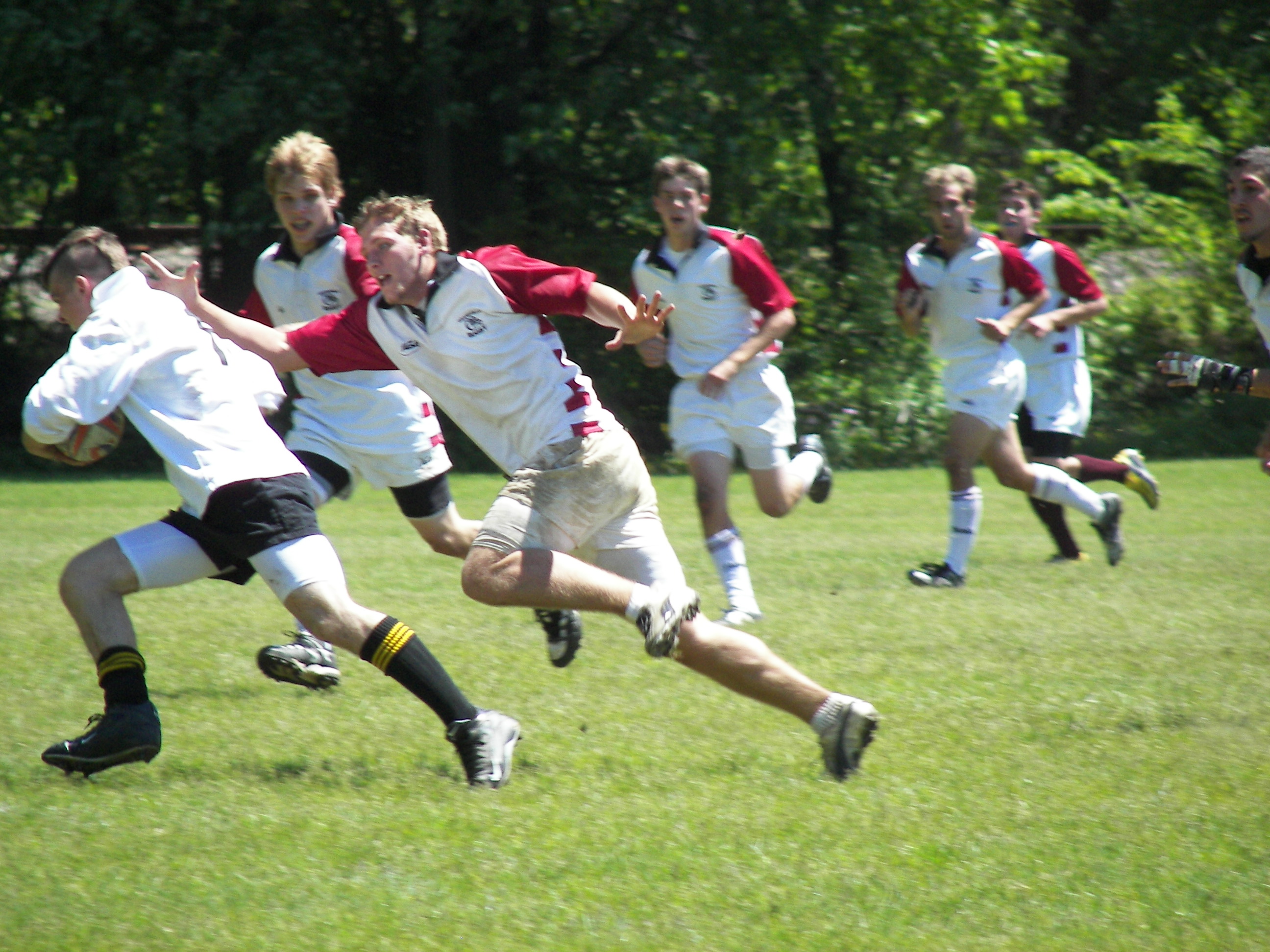|
 |
 |
|
|

In rugby, the ball can never be passed forward, but can always be kicked forward. If the ball is kicked, any player on
the team (that is kicking) are in front of the kicker are offsides and cannot tackle the opposing player untill
they run back behind were the kicker kicked. You cannot tackle someone while they are jumping in the air for a kick. All tackles
must be wrapped up and taken to the ground. When taken to the ground, the player with the ball must place the ball on the
ground immedietly with one movement. if the player is perpindicular to the sidelines and both teams are at the ball, then
a ruck is formed which is like a small scrum. the players push the opposing team until they win control by having one
foot over the tackled player. once the ruck is formed, no one can touch the ball with their hands except the scrumhalf. The
ball is then passed out to the backs. Equipment wise, there are no pads except for cleats without a toe cleat, a pair of rugby
shorts, and a team jersey. Scrum caps are allowed and some padding, but they mostly save you from a few bumps and bruises
(and maybe cauliflour ear). Only 15 players are allowed on the field for each team. When scoring a try, there must be downward
pressure on the ball to score. Except for injury, penalties, or if the ball goes out of bounds, the match does not stop. You
can't tackle a player without the ball. Their is no blocking.
|
There is only one referee or "sir" in rugby. No one can talk to the sir except the team captain. If a penalty
occurs than the sir will call both teams to the center for a "scrumdown". The opposing team has control of the scrum and their
scrumhalf feeds the ball to preferably his team. If the ball goes right out the other side, than the scrum is restarted. It
is also restarted if the scrum collapses. The obviose point of the game is to score the most points. A try, or a touchdown
in football, is worth 5 points and the point after is worth 2 points. At any point in the match, a team can kick for a feildgoal
for 3 points. Penalty kicks are also 3 points.
|
|
 |
 |
 |
 |
|

2006 Alumni Chris Griffen, our eight man, makes a diving tackle
|
Scrums: the loose forwards
|
Numbers 6-8 in a scrum are known as the loose forwards. The loose forwards consist of two flankers on either side of
the scrum. They keep the scrum going straight. The eighth man is known as the eight man (wow). He pushes the scrum and, if
the ball comes to him through the scrum by the hooker, the eight man, in some cases, will grab the ball and either run with
it or pass it out to the backs.
|
|
 |
 |
|
 |
|
 |
 |
|
Linouts
The linout occurs when the ball goes out of play.It is created
by having two players throw another player into the air by his shorts to catch the ball. Sounds painful? Well its not as bad
as it sounds (or looks), the rugby shorts are created to not tear and to prevent pinching of the very important organs they
contain.
Linouts contain two groups of these players and another man behind them in a seven set.
Some only have the first lifting group and a man behind in a fourman set and still others dont even have the fourth man and
only the three lifters.
Each team have players on either side of "the tunnel" were they each go for the ball thrown
in by the scrumhalf down the tunnel. The other players in the game not in the linout must be 10 meters back from the linout.
|
An Amazing linout by 2006 Alumni Nick
Langenberg and lifters Junior Adam (BooBoo) Sheren and Junior Chris Bergan
|
|
 |
 |
 |
 |
|

The Backs and the Scrum-half
The rest of the numbers 9-15 are known as the backs. Number nine is known as the scrumhalf. This player is like the quarterback
in football. The scrumhalf stays on the outside of a scrum and either feeds the ball oris waiting to tackle the first
person to have touch the ball once its out. Number ten is known as the flyhalf. The flyhalf calls out the plays to the backs
during the course of the match. Number eleven is known as the left wingman, number fourteen is known as the right wingman.
Numbers twelve and thirteen are known as the inside and outside centers. Number fifteen is known as the fullback.
|
This is the basic setup of all the players during a scrum
|
|
 |
 |
|
 |
|
|
 |
|
|
|

